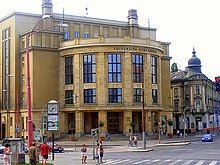Comenius University
Univerzita Komenského v Bratislave | |
 Comenius University building in central Bratislava | |
| Latin: Universitas Comeniana | |
| Type | Public |
|---|---|
| Established | 1919 |
| Rector | prof. RNDr. Karol Mičieta, PhD. |
| Students | 30,000 (2006/2007) [1] |
| Address | Šafárikovo námestie 6, 818 06 Bratislava 1 , , |
| Nickname | UK |
| Affiliations | Erasmus, Utrecht Network |
| Website | www.uniba.sk |
Comenius University in Bratislava (Slovak: Univerzita Komenského v Bratislave) is the largest university in Slovakia, with most of its faculties located in Bratislava. It was founded in 1919, shortly after the creation of Czechoslovakia. It is named after Jan Amos Comenius, a 17th century Czech teacher and philosopher.
In 2006, Comenius University had more than 30 thousand students and 2000 faculty members. As are most universities in Slovakia, it is financed mostly by the government. Although there have been plans to establish tuition fees for university students in Slovakia for years, another attempt failed to gain sufficient support in parliament in May 2005.
History
The Comenius University was established in 1919 with help from the old University of Prague. It was meant to replace the former Elisabeth university which has been located in Bratislava since 1912 as the latter has been forcefully disbanded in 1919 by Samuel Zoch, plenipotentiary župan of Slovakia, along with the intimidation of the faculty as well.[2] This has caused the majority of the university's professors (and some of the students) to take refuge in Budapest, where the university has been reestablished. It has been later moved to Pécs and renamed to University of Pécs. This persecution of former (predominantly Hungarian) pillars of education in Bratislava has necessitated the recruitment of Czech academicians. Therefore many professors of the newly established university, including its first rector, Prof. MUDr. Kristian Hynek, were Czechs, since Slovakia at that time did not have enough educated Slovak speakers who could serve as faculty members. In spite of personnel, financial, and space difficulties, the university developed research and teaching programs. The Faculty of Medicine opened in 1919, and was quickly followed by the Faculties of Law and Philosophy in 1921. The Faculty of Philosophy, besides offering programs in the humanities and social science, also educated much-needed teachers for Slovakia's high schools.
In 1937, a new university building for the Faculties of Law and Philosophy was opened in the centre of Bratislava. The building includes the Aula (hall) used for graduation ceremonies and other formal functions.
During World War II, Slovakia became nominally a republic, but was actually under the sway of Nazi Germany. The government reduced academic freedoms at the university, and the Czech professors were forced out. The university was renamed Slovak University in 1939, though the original name was reinstated in 1954. The Faculty of Science opened in 1940 and the Roman Catholic Faculty of Theology was established in 1941. Academic freedom after the end of the war in 1945 but was again cancelled in 1948 as the communists took power in Czechoslovakia, enforcing the ideology of Marxism-Leninism at Czechoslovak universities. The Roman Catholic Faculty of Theology was taken under direct control of the Ministry of Education.
However, the university continued to grow, and new faculties were established (mostly by splitting the existing faculties):
- Faculty of Education in 1946,
- Faculty of Pharmacy in 1952,
- Faculty of Physical Education and Sports in 1960,
- Faculty of Medicine in Martin in 1969, and
- Faculty of Mathematics and Physics in 1980.
After the anti-Communist so called "Velvet revolution" in 1989, the university created a democratic self-government, and mandatory courses on Marxist ideology were abolished. The Roman Catholic Faculty of Theology and the Evangelical Theological Faculty joined the university.
The transformation of Slovakia into a market economy created a need for professionals in management and financial sciences. As a result, the university established the Faculty of Management 1991 and the Faculty of Social and Economic Sciences in 2002. In 2000, the European credit transfer system was implemented to improve student mobility.
List of faculties

- Faculty of Medicine
- Jessenius Faculty of Medicine in Martin
- Faculty of Pharmacy
- Faculty of Law
- Faculty of Philosophy
- Faculty of Natural Sciences
- Faculty of Mathematics, Physics and Informatics (read also a separate article about the faculty)
- Faculty of Physical Education and Sports
- Faculty of Education
- Faculty of Management
- Faculty of Social and Economic Sciences
- Evangelical Theological Faculty
- Roman Catholic Faculty of Theology of Cyril and Methodius
Notable alumni
- Ladislav Pataki – sports scientist, athletics coach, masters athletics champion
- Ernest Valko - assassinated constitutional lawyer
- Daniel Šmihula - lawyer, political scientist and journalist
- Vladimír Palko - former Interior minister of Slovakia
See also
References
- ^ Štúdium
- ^ Béla Angyal (2002). Érdekvédelem és önszerveződés - Fejezetek a csehszlovákiai magyar pártpolitika történetéből 1918-1938 (Protection of interests and self-organization - Chapters from the history of the politics of Hungarians in Czechoslovakia) (PDF) (in Hungarian). Lilium Aurum. pp. 18–19. ISBN 80-8062-117-9. Retrieved 2011-10-09.
- Univerzita Komenského. História, Retrieved in March 2004 Template:Sk icon
- Univerzita Komenského (2006). Výročná správa za rok 2005 Retrieved in January 2007 Template:Sk icon
External links
